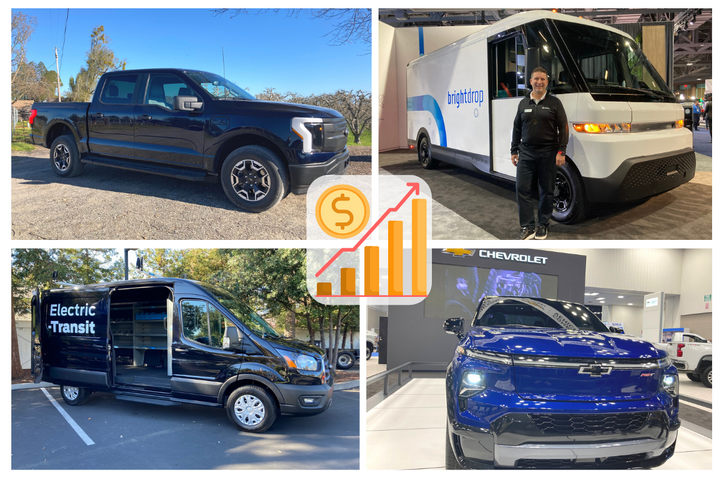
Ford has been achieving EV sales growth at twice the rate of the EV segment. That will change as General Motors begins its EV push, with nine EV models expected on the market by the end of 2023.
Photos: Chris Brown/Canva
The electric vehicle rollercoaster has, over the past year, seen record-setting sales, price hikes, and mostly recently price slashes. Added to the mix are new EV incentives from the Inflation Reduction Act, and that relief for buyers is putting new upward pressures on pricing. How do automakers ride this coaster to achieve a healthy profit?
On Ford’s quarterly investment call last week, an analyst put to Ford this elephant in the room: “Do you think you can sell a $40,000 electric crossover with a 20% gross margin?”
The profits equation is a bigger question for Ford than other automakers, particularly after Ford owned up on the call to leaving $2 billion in profits on the table due to “lack of execution” on supply chain issues and a cost structure “that isn’t competitive.” Moreover, Ford just slashed prices on Mach-E to compete with Tesla’s price cuts.
The analyst was referencing Tesla’s 20% gross margin, which is a tall order to beat. (Historically, a gross margin for Ford of 14% on the sale of the car is healthy.) In general, margins on EVs are already squeezed as automakers deal with rising materials costs and expensive plant retooling. Ford has its work cut out for it.
Radically Simplified Models
In his prepared remarks, Ford’s CEO Jim Farley had already half-answered the question. The second generation of Ford’s EVs will be “radically simplified,” with only three body styles a handful of orderable combinations that could garner up to 1 million units each in sales, but with a smaller bill of materials and lower manufacturing costs.
During the Q&A, CFO John Lawler stepped in on greater detail to spell out the path to profitability on EVs. He said Ford went through a learning process in designing its first cycle of EVs — the Ford E-Transit, F-150 Lightning, and Mustang Mach-E.
“We didn’t know that our wiring harness for Mach-E was 1.6 kilometers longer than it needed to be,” Lawler said. “We didn’t know it’s 70 lbs. heavier and that’s worth $300 (more) a battery. We didn’t know that we underinvested in braking technology to save on the battery size. … We didn’t know that we needed the world’s best aerodynamics to get the size of the battery smaller.”
These issues are being addressed in the second cycle, which according to Lawler will allow Ford to meet its more immediate and modest goal on EVs of 8% EBIT (a different calculation than gross profit).
Real Money on Software
Lawler expects brands will protect growth with their EVs, and therefore to “expect negative pricing,” which makes profitability on non-vehicle items such as software even more critical. For Ford, the software play is underpinned by its next-gen updatable electric architecture.
The full offering and revenue potential on the software side is just beginning to be realized, as Ford Pro roles out products for SMBs around fleet management, telematics, and EV charging. “What we’ve learned on Pro is we can make real money on software,” Lawler said.
Another part of the profit equation is to incorporate the Tesla sales model, or parts of it. Next January, Ford intends to sell EVs with virtually no inventory and non-negotiated prices. Different than Tesla and owing to franchise laws, those prices will be set by local dealers. Ford’s EVs will be bought through an e-commerce platform that foregoes the showroom model in favor of remote pickup and delivery.
Regarding product segments, Farley said the crossover is turning out to be the core of the EV business. “We are not going to be playing in the two-row commodity SUV market,” he said, “because we tried that in the ICE business, and it didn’t really work out for us.”
Fleets and EVs
Listening to Ford, demand is healthy. Interestingly, Farley said that 60% of Ford’s U.S. fleet managers “plan to add an electric vehicle within the next two years” to their fleet. Ford’s EV sales growth is twice the rate of the EV segment, at least for now, because they have new products to sell. That’ll change as General Motors begins its EV model push, with nine EV models expected on the market by the end of 2023.
On GM’s call, CFO Paul Jacobson was asked the same question on how GM would get to 20% gross margins faster. Jacobson pointed to the present frictional costs of running concurrent operations for ICE vehicles and EVs. Those should ease with the pivot more toward EVs.
GM’s CEO Mary Barra reiterated GM’s goal to “achieve solid EV profitability in 2025.”
Fleets also represent incremental EV business for GM. BrightDrop, which is on track for $1 billion in sales this year, is “an all-growth opportunity for us,” Barra said.
GM intends EV sales to fleets will come with higher margins: “We’re going to make sure that as we grow our fleet, commercial, (and) rental business, it has an appropriate profitability profile, not from the days of 10 or 15 years ago,” said Barra, mentioned the Chevrolet Silverado EV work truck.
Regarding product segments, GM differentiates slightly from Ford, which made the repeated point it will stay away from “commoditization.” GM certainly has non-commoditized EVs in its lineup, including the Cadillac Lyriq and Hummer EV.
But GM is also working to be the EV provider to the masses. It’s doubling down on Chevrolet Bolt production and feels that Chevrolet Equinox EV will be at the right price point yet with enough range and charging capability to be a daily driver. “More than one third of the customers interested in the Equinox EV say affordability is their key consideration,” Barra said.
Originally posted on Automotive Fleet
